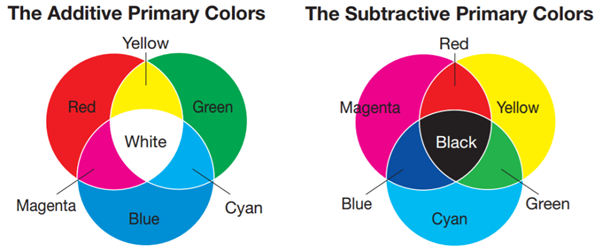Primary Colours
Generally speaking we learnt in school that primary colours consist of yellow, blue, and red. These colours cannot be created by mixing any other colours together. Rather, they combine with each other to create secondary colours, which in turn combine to create tertiary colours. Although this is true, there is still more to learn about primary colours, and contrary to popular opinion, there are actually two main kinds of primary colours - additive primary colours and subtractive primary colours. To make all of the colours of the rainbow, both types of primary colours are needed. Grab your paints and let's take a closer look at what these primary colours are.
Additive Primary Colours
Additive colours are those that come directly from a source and before an object reflects the light. These hues are red, green, and blue (often known as RGB). If all three of these colours were mixed together in the form of light, they would produce white. These colours are more often used to describe colour in physics and help explain the science behind properties there. Some examples where additive primary colours are used include:
- television
- theatrical lighting
- computer monitors
Subtractive Primary Colours
Subtractive hues are those that have been caused by light reflecting off of them. Subtractive hues consist of cyan, magenta and yellow, such as in the example below, and more often used in printing, paint pigments, ink, coloured textiles, and other types of coloured coating that we encounter on a daily basis. If all three subtractive primary colours were mixed together, they would produce black. Some examples where subtractive primary colours are used include:
- textiles
- printing
- paints

Colour Mixing Primary Colours in Art
Although interesting to see how different colours are considered primary colours across the industries, it’s important to fall back on our original yellow, blue and red as our primary colours when referring to the primary colours used by artists. As artists, it's important we understand how to mix primary colours together in order to create secondary and tertiary for our works of art. If we mix the following primary colours, we get these results:
- Red and yellow = orange
- Blue and yellow = green
- Red and blue = purple / violet

Keep in mind that equal parts of both colours will create the exact outcome as shown above, however, if you’re after a darker orange for example, you can simply mix more red than yellow into your mixture, while adding more yellow over red, will create a lighter orange. The same applies to creating a lighter or darker green and lighter or darker purple. You can also lighten or darken colours by adding white paint to make your colour lighter or black to make it darker.
We hope that through this article, we have inspired your appreciation for primary colours. You can find our handy paint supplies here, including acrylic paints, oil paints, watercolour paints and gouache paints. Plus what’s paints when you don’t have brushes? Check out our brush range here, including acrylic brushes, oil brushes, watercolour brushes and even brush sets!
Related Articles
